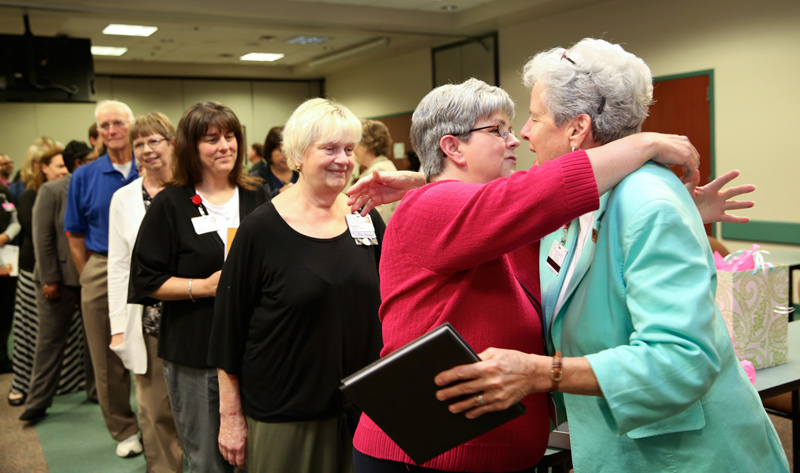PARMA, Ohio—There was a time years ago when Flor Molina was working in a Southern California sewing factory, earning a scant wage and sleeping at night in a storage room not far from the factory floor.
On top of that, her bosses forbid her from talking with the other employees.
It was not the life she imagined when she accepted an offer 16 years ago from a factory recruiter in her native Mexico who promised good pay and decent housing.
Molina had made the difficult decision to leave her mother and children behind in Mexico for six months so she could save the $5,000 she needed to start her own sewing business. She had been sewing clothes and gained a decent customer base; she dreamed of taking the next step as an entrepreneur.
After 40 days in the factory, Molina escaped and found help. She realized she had become a victim of unscrupulous human traffickers whose only value to them was her labor.
Now 46 and living in Los Angeles, Molina told her story Oct. 26 to 60 participants in the Borders Are not Barriers conference of women religious, a handful of priests and justice ministry workers from throughout the Western Hemisphere working to stop human trafficking.
The gathering at the Jesuit Retreat Center in Parma was the second in two years of nine networks extending from South America to Canada that are part of the worldwide Talitha Kum International Network of Consecrated Life Against Trafficking in Persons. The first meeting was in Bogota, Colombia.
“This is a global crime. It’s affecting all kinds of our brothers and sisters,” said Sister Anne Victory of Cleveland, a member of the Sisters of the Humility of Mary. She is president of U.S. Catholic Sisters Against Human Trafficking, which convened the gathering.
“We first have to know about the issue and that it isn’t just happening somewhere else. It’s happening right here,” Sister Anne told Catholic News Service. “Certainly for us, nobody should be sold. That’s against the human dignity piece of Catholic social teaching.”
Trafficking is known as modern-day slavery because human beings are essentially bought and sold in a highly profitable industry. The International Labor Organization reported in 2014 that traffickers earn $150 billion annually.
A September 2017 report from the ILO and Walk Free Foundation said an estimated 24.9 million people were being trafficked around the world. The number included 16 million being exploited for labor, 4.8 million for sex and 4.1 million for state-imposed forced labor.
The Ohio gathering also attracted the interest of the Vatican. Diego Carambula, regional coordinator of the migrants and refugees section of the Dicastery for Promoting Integral Human Development, told CNS he planned to report on the sisters’ efforts in the hope of offering additional support for their work.
Primarily it has been women religious who have led the church’s response to trafficking. Congregations of women religious have developed programs in countries around the world, with the most active in the Western Hemisphere.
Participants in the four-day conference agreed to strengthen cross-cultural efforts; more readily collaborate, share resources and information; and advocate across international borders for stronger laws and government commitments to crackdown on unscrupulous trafficking networks.
Just as importantly, participants told CNS, a broader sense of unity emerged as those on the front lines of anti-trafficking efforts realized they were not alone in aiding trafficking victims and confronting traffickers, often under threat of harm.
Sister Margaret Nacke, 84, a member of the Sisters of St. Joseph of Concordia, Kansas, has addressed trafficking concerns for more than a decade. She acknowledged the work is centered on protecting human dignity, especially of women and children.
“It’s sensitivity to the environment and how we treat people,” she said. “We’re treating people as products to be bought, shared, traded. We have to have a full look at what it means to be a human being. What does that mean for freedom? I can take your freedom for my freedom?”
Helping the world understand its role in protecting human dignity stands at the center of the work of the Rome-based Talitha Kum network, explained Comboni Sister Gabriella Bottani, coordinator.
“One of the most important things of Talitha Kum is it is a space that grows from the leadership of women religious. We have a flavor of the female sensitivity to respond,” she told CNS.
Overall, about 1,000 women religious in 22 networks across 76 countries work on trafficking, Sister Gabriella said.
Whether it is Venezuelans fleeing to Brazil or Central Americans trying to enter the United States, she said the migration of people around the world feeds the trafficking industry as people move from country to country to escape poverty, with the poorest often the unwilling prey of traffickers.
Meeting women from the global south who live amid dire poverty to prevent young people from being trafficked inspired two members of the Sisters of the Holy Names of Jesus and Mary who are part of CATHII, the Internal and International Human Trafficking Action Committee in Montreal.
Sister Claudette Bastien and Sister Lise Gagnon agreed that it was helpful to “feel the passion” of the international response to trafficking.
“It’s good to know we are together,” Sister Lise said.
That feeling of solidarity also reached Sister Angelina Segoviano, a member of the Oblate Sisters of the Most Holy Redeemer who works in trafficking ministry as part of the Red Rama network in Guatemala City. She helps young women and children understand the consequences of agreeing to relocate with the promise of work.
“We’re among the poorest people and in the communities of people suffering in human trafficking,” she said. “We help them understand that they are human beings, not something to be merchandized.”
But trafficking isn’t limited to people from poor communities south of the U.S. border. Benedictine Sister Teresa Ann Wolf, director of the Benedictine Multicultural Center in Watertown, South Dakota, knows trafficking occurs even in her part of the country.
She cited the annual Sturgis Motorcycle Rally in western South Dakota, which draws hundreds of thousands of people, as being a regular target of sex traffickers. She compared the event to a Super Bowl host city where sex trafficking spikes each February. Beyond that, the state’s fall pheasant hunting season also presents another window for trafficking, she said.
“There’s all these people coming in with money and are looking for a good time. Wherever you have an event that attracts men, it’s an opportunity for sex trafficking,” she said.
The Benedictine’s effort focuses on building a broad network in the community, including law enforcement to find assistance for women who find themselves being trafficked and educational programs at schools and community groups.
Near the end of the meeting, Sister Gabriella called on the women religious to become more organized than the traffickers.
“Human trafficking is increasing,” she said in a call to action. “Women and children face discrimination and the patriarchal order of society. … We’re called to recognize the presence of God in our brothers and sisters.”
By Dennis Sadowski/Catholic News Service



